From an administration point of view, the Eastern Part of Uttarakhand state is known as Kumaon Division. Under the Kumaon division, currently Almora, Bageshwar, Pithoragarh, Champawat, Nainital and Udhamsingh Nagar Districts are included. Geographically, the district Udham Singh Nagar falls in the plains while all other districts are in the mountainous regions. The spoken language in these parts is mainly Kumauni except the Khatima and Sitarganj tehsils of Udham Singh Nagar district where the spoken dialect is ‘Tharu’, the Munsiyari tehsil where the spoken dialect is ‘Johari’, the Didihat tehsil where the spoken dialect is ‘Raji’, the Bajpur tehsil where the ‘Buksa’ dialect is spoken and the Dharchula tehsil of Pithoragarh district where the ‘RungLo’ dialect is spoken.. This article is premised on the consideration of the Kumauni language-bound region as a cultural unit. It will be necessary to clarify here that the word Kumaon Anchal i.e region, is basically an
enclosure where the Kumauni language is largely spoken and where uniform
characteristics are found socially and culturally.
Marriage has been considered as a significant ritual of life in Indian Hindu society since ancient times. Marriage is not just a conflux of men and women but it is a social system from where it starts to pursue human ancestry, fulfill family obligations and connect with different dimensions of life. If we talk about the prevailing marital practices in Kumaon region, we find that there is a tradition of marriage and customs arranged in accordance with the socially formalized systems with a few diversities and variations. If we talk about
the pre-1920 period, there were three types of marital relations
prevalent in Kumaon region (source: Pannalal, ICS, 1920, government records),
of which details are given below:
1 Wedded wife: When a woman is married to any man as per rituals & local customs that she is the ‘wedded wife’. This kind of marital relationship is most prevalent in the ‘Kumaon Anchal’.
2 Dhanti: The wife of any other person, who is a
widow, or who may be abandoned by her husband, when brought home as a wife, is
called a dhanti. The special thing is
that dhanti is kept like a maiden
without rituals. In practice, it was considered necessary to pay the price to
the former husband or the nearest family.
3 Tekuwa: When a woman,
especially a widow, puts a man in her house as a husband, then that person is
called tekuwa, kathwa or haliya. Such a relationship used to be
termed as tekuwa in the Kumaon.
According
to elderly people of the region, the dhanti,
tekuwa and damtaro marriages were prevalent in the Kumaoni society until about eight decades ago. These kind of marriages or relationships are not usually in practice in contemporary society. When a poor family was unable to marry their daughter, then they would take money from the groom's family in lieu of the marriage and then the girl was married. This marriage was called damataro vivaah. With socio-economic changes and growing education and awareness, the society has now started to oppose the older belief-systems of marriage that are not relevant in today’s developed society (source: Shri Devaki Nandan Lohani,
village Lohana).
In
earlier times, the practice of child marriages was prevalent in the Kumaon
Anchal. However, at present this practice has almost come to an end. This was
mainly because of an open society in the mountains, where there was no practice
of seclusion. People preferred to marry off their daughters when they were
12-13 years old as the youth of the region were engaged mainly in agriculture
and animal husbandry leading to possibilities of interaction between local boys
and girls of the villages in the region(Source:
Dr. Sher Singh Bisht, 2009).
Three kinds of marriages are currently practiced in Kumaon Anchal (Source:
Deepa Pandey, 1988) which are described below.
1) 'Aanchal' Vivah: In Kumaon, this is the most commonly practiced form of marriage. In this kind of marriage, people from the groom’s side go to the bride's house with a procession. The groom's and bride's 'aanchal' (which is a long yellow and thin cloth) is interlocked. The bride’s father gives away the bride, i.e. kanyadan to
the groom. 'Aanchal' marriage is done
in accordance with Vaidic rituals (as per the Vedas) and local customs.
2) Sarol Vivah: In
Kumaon, this type of marriage is also called
bada or dola. In this marriage, the bride is brought to the house of the groom accompanied by the playing of drums and without any rituals. The marriage is then performed in a ritualistic manner in the groom’s house. In this marriage, the bride and the groom do not wear the customary crowns on their heads. Now, this practice of sarol marriages are usually not seen in
the Kumaon region.
3) Mandir Vivah: When
the bride and groom are married in a temple, then is called a mandir vivah. In Kumaon Anchal, there
are several such temples, including temples of Golu devta which is located in Chitai near Almora and the ‘Ghorakhal’ in Nainital, where marriages are usually conducted. These rituals are usually completed in a day’s time, in the presence of the family members of the bride and the groom
Sequence of 'Aanchal' or Vaidic marriage
In the 'Aanchal' or Vaidic marriage ceremony, the
role of rituals i.e. sanskaars is the
most prominent. The main rituals of Vaidic marriage are panigrahan sanskaar or kanyadaan,
saptapadi and agni pradakshina or
fere (Source: Shri Bhava Jee Pandit, Purohit, Village Kande). Apart from
this, a few small rites are performed
before and after marriage. The special thing is that all the rituals of
marriage are conducted amid the chant of vaidic
mantras. It would be appropriate to briefly describe the nature of rituals,
rites and local customs used in the Kumaun Anchal, the sequential steps, as given
below.
Marriage Decision: In the
Kumaon region, appropriate brides and grooms are sought among homogeneous
families of equivalent statures. The marriage is decided on the basis of the matching
of the birth chart or horoscope, which is called the kundli saamya haige. After this, the date of marriage is decided by
the kul purohit at an auspicious
time, which is called lagna sujhi go.
Invitation: After
the date of marriage is fixed, on behalf of both the bride and the groom, invitations
are extended to friends, relatives and others. There is also a tradition of
giving oral invitations to villagers in Kumaon area. Nowadays the trend of distributing
printed invitations in person and through post has also increased. Folklores of
the Kumaon region describe invitations given through parrots, as depicted in
this song:
“Suva... o suva.. living in the forest ... you have a beautiful green-coloured body.. yellow beak ... flickering eyes ... and sharp eye-sight ... O Suva you go and invite all the citizens”
suva re suva, banakandi suva,
jaa suva nagreen nuyat diya
hariya tero gaat, Pingli tere thung,
ratnari teri aankhi, najar teri banki
suva re suva, banakandi suva,
jaa suva nagreen nuyat diya
Tilak: Applying tilak is a small ritual, and done before
the marriage. It is known as Pithiya Laguna. Five or seven people from the groom’s side visit the bride’s house and apply tilak and give gifts to the bride and her family including fruits, sweets, clothes, money, etc. Gifts are also given by the bride’s family to the groom’s family. The presence of the groom is not necessary for this ritual, which is also considered like an engagement ceremony.
Suwal Patai: The program
of suwal pathai is done either one
day or also three or five days before the main marriage ceremony, by both the
families. In this distinct tradition of suwal
patai, papad (suwal) made of rice flour and laddoo (laddu) are made from black
sesame (Source: Mrs. Maya Tiwari,
Dehradun). Ancestors, pitra or purvaj, are
also invited by singing songs, wherein the bee or ‘bhaura’ is requested to go to heaven and invite the ancestors. The humble bee says that it does not know the names and the villages of the ancestors and also where the door leading to the ancestors would be. The singers then tell him that the golden gates or doors leading to the ancestors would be where he can see the silver lining of the clouds, the Sun and the Moon.
jaana-jaana bhanvari pitron ka lokaa,pitran nuyti enau ni jananu,gon ni jananu,kaan hola pitar dwaar e
aadha sarag baadal rekh, aadha saragchandra suraji e
aadha sarag pitran ko dwaar,jaan re hola sunu ka dwaar e
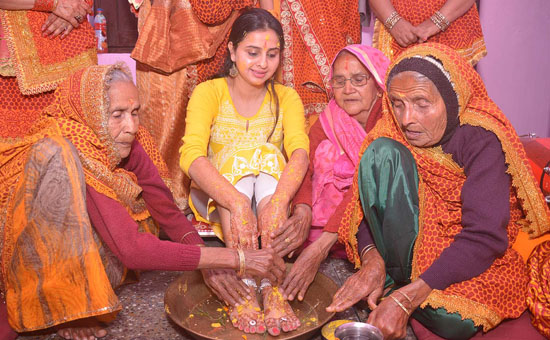 Haldi Ceremony
Haldi Ceremony Ganesha Pooja: The
families of the bride and the groom worship Lord Ganesha before the start of
the marriage ceremonies, praying for the rituals to be completed without any
obstacles. This is called the Ganesh me doob dharan. After this, further ceremonies
are duly commenced. The principal lamp or
pradhaan diya is lit up after aabdev
purvanga, Ganesh poojaa, Matrika pujaa Nandishradh, punanahavachan,
kalash sthaapan and Navagraha pooja.
Along with these rituals, the bride and groom are anointed with turmeric or haldi
by their close relatives after which, the bride and the groom take a ceremonial
bath. A bracelet in the form of a small bale in which betelnut and coins are
placed in a yellow colored piece of cloth, is tied around the hands of the
bride and the groom. After Ganesh pooja, the bride’s parents keep a fast till the time she leaves for the groom’s house i.e. her vidaaee.
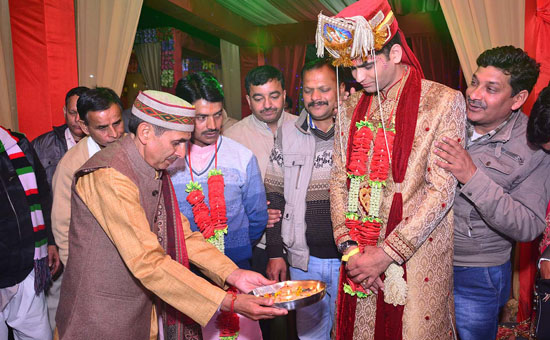 Dhuliarghay
Dhuliarghay
Dhuliarghay: In the twilight, when the procession reaches the bride's door, the groom’s party is welcomed by unmarried girls, who carry urns filled with water or kalash, on
their heads. The groom is carried and brought to the Dhuliarghay chauki in
the courtyard, which made of red clay and rice-flour known as biswar. This geometrical design includes
different symbols such as kamal, kalash,
shankh, chakra and gada etc. Two wooden
stools or chaukis are placed on this.
The groom and the priest are respectfully made to stand on these chaukis. The groom or var is worshipped as a form of Vishnu.
After washing the feet of var and aacharya, the daughter's father applies tilak and gives gifts including money and garments, etc. Welcoming the procession, women sing the mangal geet
(Source: Mrs. Deepa Lohani, Haldwani).
chhaaja mein baithee samadhani poochhai ko holo dulha
ko baaba e
ko holo dulha ko daada e, ko holo dulha ko taoo e
kaalo chho jooto,pingalee chh taanko,vee holo dulha ko baaba e
khokhalo chho boodho,lambee chh daadee vee holo dulha ko daada e
laal dushaala,shvet chh lukuda, vee holo dulha ko taoo e
After
the community feast, according to the horoscopes of the bride and the groom an auspicious
time for the marriage ritual - panigrahaan sanskaar or kanyadaan - is fixed.
Panigrahaan or Kanyadaan:
In the Kumaon region, the ritual of kanyadaan
was traditionally conducted in virtually the lower level of the house or ghoth. Now this ritual is conducted in a
mandap installed in a beautifully decorated
hall. The mother of the bride and the other women bring her to the mandap. People from the groom and bride
side, sit facing the east and west directions, respectively (Source: Mrs Bharti Pandey, 2017). After
the worship of Lord Ganesh, the rite of kanyadaan
is duly started. Mangal geet are sung
and the bride father, after washing the feet of the bridegroom, applies tilak.
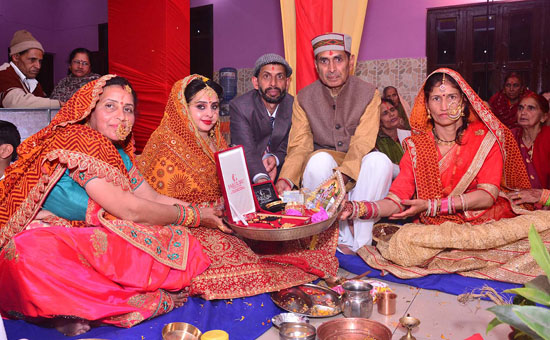 Chholi or gifts
Chholi or gifts
After
this, both sides share chholi or gift
items like fruits, sweets, nuts, clothes, money and ornaments. The bride is adorned
with the clothes and ornaments brought from the bridegroom side. Meanwhile, priests
from both sides communicate and get acquainted with details of the gotras and ancestral lineage of both
families. During the ritual of kanyadaan the father of the bride sits facing the north and the bride sits facing the western direction. After this, the father takes the palm of his daughter’s hand and places it on his own palm. Then, the bride’s mother and other family members pour water from a small pot or gaduwa, onto the palms of the father on which the bride’s and groom’s palms are also placed. It is known as gaduve ki dhaar denaa (Source: Shri Bhava ji Pandit, Purohit, Gram Kande). This moment is very emotional for the parents and described beautifully in a song which says, “... Mother has a gaduwa on her hand ........ water is falling from it ... The palm of daughter's hand is in the father's hand.. and father's hands are trembling ..”
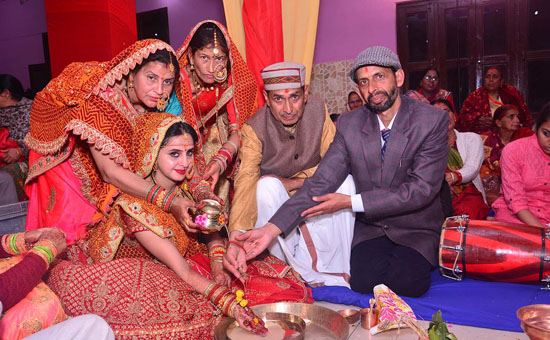 Gaduve ki dhaar denaa
Gaduve ki dhaar denaa
haath gaduva le maayadee
thaadee
babajyoo kush kee daalee e
thar-thar kaampe haath bavbajyoo
tumhaare
jaise vaayu se paat e
ham nahin kaampe laado hamaaree
ve to kaampe kush kee daal e
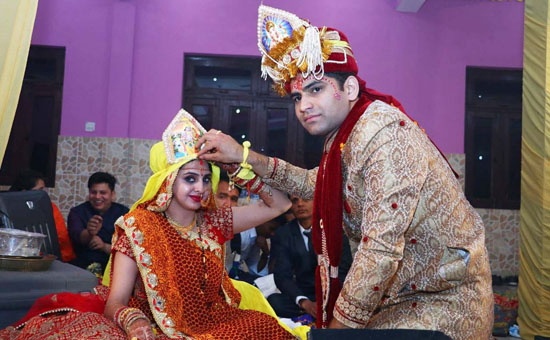 Sindhur
Sindhur
After placing the gaduve ki dhaar, the bride goes beside the groom. The groom then,
fills her forehead with vermilion and applies tilak. Meanwhile, a crown is
placed on the heads of the bride and the groom. After this, the 'aanchal bandhan'
is done, which is a tradition of interlocking the aanchal (a long yellow colour cloth) between the bride and groom. In this way the girl becomes a member of the groom’s family now. The practice of shayyadan is fulfilled and aarti is done for the bride and the groom,
who are considered as Lakshmi-Narayana.
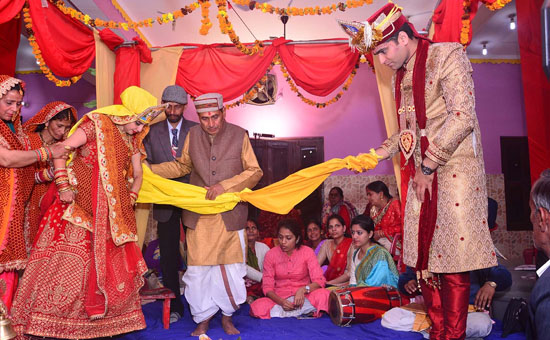 Aanchal Bandhan
Aanchal Bandhan
Saptapadhi: After
completion of kanyadaan, the next
ritual is to take saptapadhi or seven rounds around the fire. The special thing is that in this ritual, the girl's parents do not get involved. Once the holy fire is lit and Hom-yagya is done, according to the saptapadhi, the bride and groom take seven rounds around the fire. During this time, the bride's brother gives her kheel
or a kind of roasted rice, and the bride keeps dropping it as she takes her
seven rounds. After the seven rounds around the fire or fere are completed, seven lamps or diye are lit and after extinguishing the flames of six of those
lamps, the seventh lamp is worshipped. After this, vermilion is applied to the
forehead of the bride and tilak is done. This is followed by feeding of curds
& sweet or dahi-
bataasha to the bride and the groom.
After completion of all the marriage rituals, the bride is sent to her in-laws’ house on a dolee. The bride’s mother gets extremely emotional and pleads with the groom's party to not give her daughter any distress. These poignant moments are described once again in a lovely folk song, “do not give any distress to my lovely daughter ..... I have brought her up with a lot of love...”
are-are loko pandit loko, sajjan loko
meree betee duhkh jan diya ho
das dhaaree mainle doodh pivaayo
meree betee duhkh jan diya ho
das tumbee mainle tel chubaayo
das gatharee mainle kapada molaayo
meree dhiya duhkh jan diya ho
When the bride reaches her in-laws’ house after marriage, she is ceremonially received by the groom's mother or his elder sister and introduced to all the members of the family and their relatives. The new bride is told about her future duties and responsibilities. After these ceremonies, the new bride goes to the naula or dhara (water spring), taking an urn
of water or kalash on her head along
with other ladies of the family. The bride then immerses the materials used for
the pooja in the water spring. All members
of the family pray for the happiness of the married couple and shower them with
blessings.
Some ritualistic features of Kumauni marriages
The
traditional wedding rituals of the Kumaon region have a distinct identity of
their own. Generally, in the rural areas, marriage rituals are conducted in three
places around the house - the courtyard of the house (dhuliarghay), the ground floor of the house or the goth (kanyadaan) and outside the house, (Agni Pradakshina). (Source: Shri
Bhava Ji Pandit, Purohit).
On the occasion
of suwal pathai symbolical effigies
of Samdhi and Samdhin are made from
black sesame, and mutually interchanged by the families of the bride and the
groom in the panigrahan sanskaar. Women
wear traditional attire called rangwali pichhodas.
Until a few years ago, rangwali pichhodas were made at home and dyed in yellow colour, and anointed with spherical henna marks. But now these outfits are easily available in the market. Before the commencement of the marriage procession from the groom's side, a special person Musbhijai /
Jolee is sent to the bride home with a pot of curd (dahi ki theki) and a green leafy vegetable. This symbolizes the completion of preparations by the groom’s side and signals the imminent arrival of the procession at the bride’s place.
In the
marriages of the Rajput community, chholia
or a group of dancers, dance along with the procession wielding shields and
swords. The ceremonial flags or nishaans
in red and white colours are taken ahead of and at the rear of the procession. Traditional
instruments like the dhol, damaau, ransingh and maskakbeen are normally practiced played in the marriage ceremonies. When the procession reaches the bride's house, the bride’s sister cleverly tries to hide the shoes of the groom and demands money
from the groom before returning it to him. Mangal
geet are also sung by Gidari (a
group of female singers) during the rituals.
In Kumaoni
weddings, there is a tradition of considering the bride and groom as Gods and
hence it is also a custom to adorn their heads with crowns. The pictures of Ganesha and Radha-Krishna are placed in the crowns. Kurmu (a dot shaped design) is marked on the face of groom. At the
time of kanyadaan, both families
indulge in satire and gossip through the songs that add to the delightfully
charming atmosphere.
When it is time for the marriage procession to leave for the groom’s house, family members of the bride apply tilak to all the guests and give them dakshina with respect. Naariyal 'golaas' are also given to family members. The bride and the groom return to the bride’s house after a few days, which is called dooragaman (returning arrival) or durgun. After marriage, when the mother of the groom arrives at bride’s maternal hometown for the first time, it is known as samdhyon bhetna.
(Source: Mrs. Deepa Lohani and Mrs Maya
Tiwari, Haldwani).
While
modernism has influenced the culture, dialects, traditions and customs of the
Kumaon region, including marriage rituals, it is a matter of joy that the rural
areas are largely still traditional and even migrant families living in cities
in India as well as in other countries, are also following traditional customs
and necessary rituals as per Vedic parampara
or marriage practices. This certainly heralds well for the development and conservation
of Kumaoni culture.
Author is Research Associate at Doon Library and Research
Center, 21, Parade Ground, Dehradun.
To read the same article in HINDI
References
1. Devi, Ganesh N. & Bhatt, Uma and
Pathak, Shekhar, (Edited), 2011, Bhartiya
Bhasha Lok Survekshan: Uttarakhand ki Bhashayen Volume 30, Part- I,
Hyderabad, Orient Blackswan Pvt.
2. Nautiyal, Bhagwati Prasad, 2013, Madhya Himalayi Bhasha,Sanskrti evm Lok
Sahitya, Dehradun, Samay Sakshya Prakashan.
3. Pannalal, ICS, (Translation, Thapliyal,
Prakash), 2008, Kumaon Me Prathagat
Kanoon, Adibadri,Himalaya Sanchetna Sansthan.
4. Pandey Indu, 2006, Uttaranchal Ek Saanskrtik Jhalak: Vivah-Geet-Sangeet, Faridabad,
Indu Pandey.
5. Pande, Bharti, 2017, Kumaon Ki Anmol Saanskrtik Viraasat, Dehradun, Binsar Publications.
6. Petshali, Jugal Kishore and Kunjwal, Lata,
2003, Kumaon Ke Sanskaar Geet, Delhi,
Takshashila Prakashan.
7. Bisht, Sher Singh, 2009, Kumaon Himalaya: sanskrati Evm samaaj, Haldwani,
Ankit Prakashan.
8. Bhatt, Diva, 1999, Himalayaee Lok Jeevan: Kumaun
and Garhwal, Haldwani, Adhaarshila Prakashan.
9. Bisht, B. S., 1997, Uttaranchal: Gramin Samuday, Pichhadi Jaati Evam Janjatiya Paridrashya,
Almora, shri Almora Book Depot.
10. Vashishta, Sudarshan, 2010, Himalaya Gatha-4: Samaj-sanskrti, Delhi,
Suhani Books.
11. Waldia, K. S., 1988, Kumaon: Land and People, (Edited), Nainital, Gyanoday Prakashan.
Interviews and talks
1. Interview with Mr. Devaki Nandan Lohani,
Senior Citizen, Village Lohna, February 16, 2018.
2. Personal talk from Mrs. Deepa Lohani, Housewife,
Haldwani, February 19, 2018.
3. Personal talk from Mrs. Maya Tiwari,
Housewife, Dehradun, August, 21, 2018.
4. Personal talk from Shri Bhava ji Pandit,
Purohit, Gram Kande, February, 19, 2018.